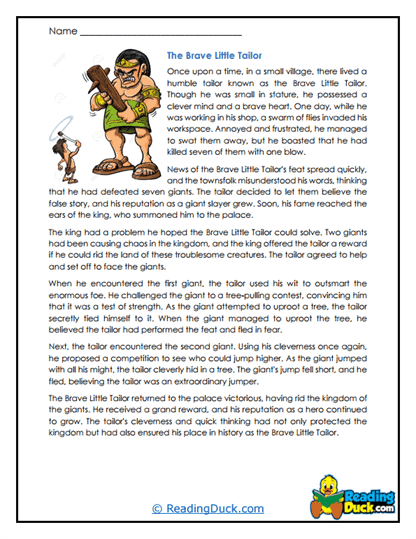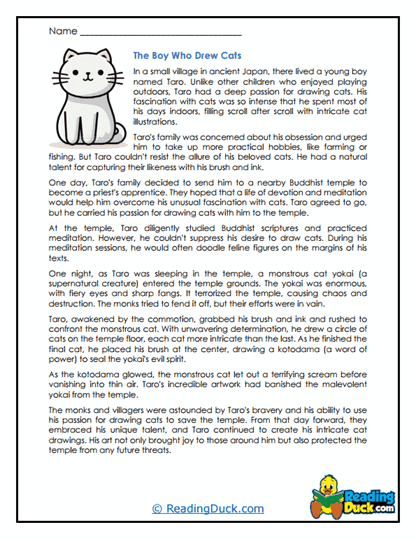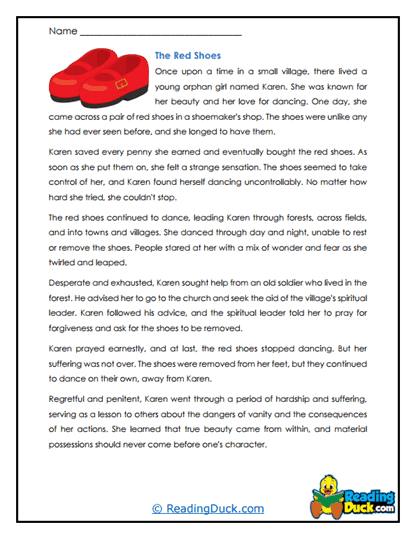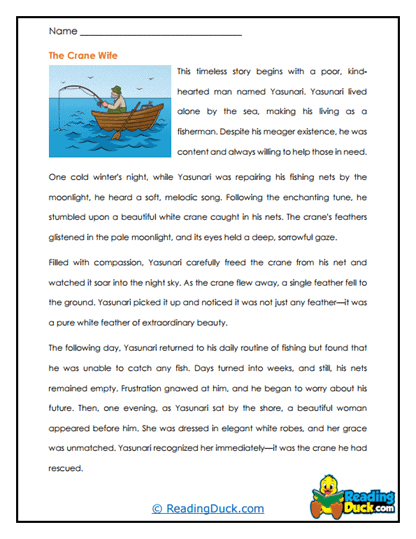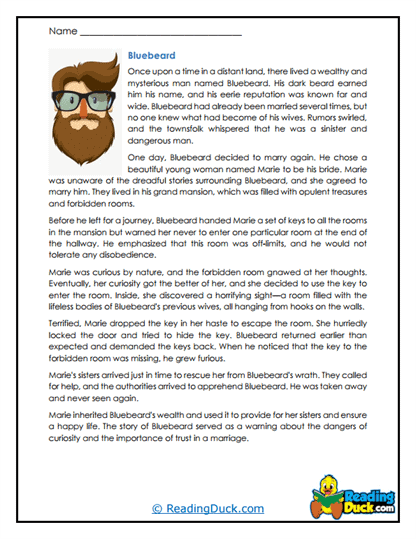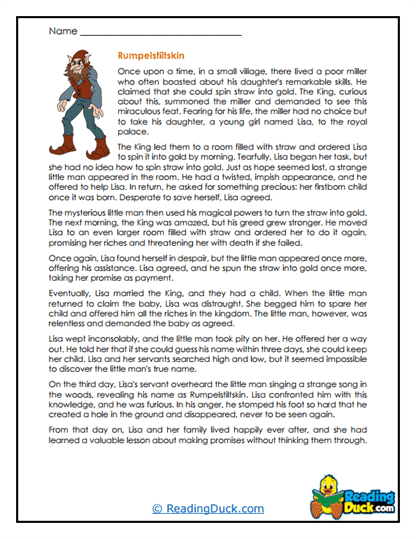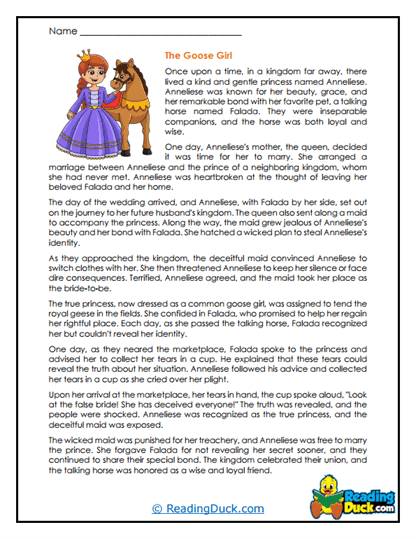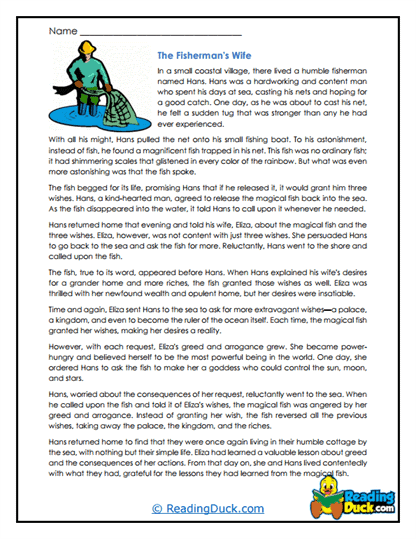Folklore Worksheets
About Our Folklore Worksheets
Our Folklore Worksheets are designed to introduce students to the rich, culturally diverse world of folklore while developing essential reading comprehension, critical thinking, and creative interpretation skills. Each worksheet set features a carefully selected reading passage that aligns with the folklore genre, followed by a variety of multiple-choice, short-answer, and open-ended response questions. These worksheets guide students through a deeper analysis of traditional stories, helping them connect with timeless narratives that have been passed down through generations.
All of the worksheets are presented in PDF format, making them simple to download, view, and print. This format ensures that the worksheets are accessible for both classroom use and independent study. Additionally, each worksheet set includes a downloadable answer key, allowing for quick and easy grading and review. These worksheets are versatile, supporting both individual learning and group activities, while offering students a structured, engaging way to explore the key elements of folklore.
By engaging with our Folklore Worksheets, students will not only gain a better understanding of traditional tales and their meanings but also sharpen their ability to think critically about cultural narratives and explore the storytelling techniques that have shaped literature and society for centuries.
Exploring the World of Folklore: Themes and Significance
Folklore is a genre rooted in cultural traditions and encompasses a wide range of stories, myths, legends, fables, and oral histories. These stories often reflect the values, fears, and beliefs of the communities that created them, making folklore a powerful vehicle for understanding the moral and cultural lessons of different societies. Common themes in folklore include good versus evil, human nature, survival, cleverness, and justice, and these themes are often conveyed through symbolic characters, such as tricksters, heroes, or supernatural beings.
One of the defining features of folklore is its oral tradition. These stories were often passed down verbally from generation to generation before being recorded in writing. As a result, folklore tends to be rich in symbolism, repetition, and universal themes, making it easily recognizable and relatable across different cultures. Many folklore stories feature moral lessons or cautionary tales designed to teach the listeners or readers how to navigate the challenges of life. For instance, trickster figures like Br’er Rabbit or Anansi often use cleverness to outsmart more powerful enemies, reinforcing the value of wit and resourcefulness.
Folklore plays a crucial role in the broader literary landscape because it preserves the cultural heritage of communities while also influencing modern storytelling. Many contemporary authors and filmmakers draw inspiration from folklore, incorporating elements like mythical creatures, archetypal characters, and moral lessons into their work. By studying folklore, students gain insight into how stories reflect the values and experiences of different societies while also learning how these traditional tales continue to shape fiction today.
Our Folklore Worksheets help students delve into these timeless stories, offering them a way to explore the narrative techniques, themes, and cultural significance of folklore. By analyzing the structure and purpose of these tales, students gain a deeper understanding of the genre and its enduring impact on storytelling.
Structure of the Folklore Worksheets: Engaging with Traditional Tales
Each set of Folklore Worksheets is carefully crafted to engage students with key elements of folklore, while also supporting reading comprehension and literary analysis. The worksheets begin with a reading passage—a traditional tale or myth—that introduces students to the core themes and narrative structure of the genre. This passage serves as the foundation for the questions that follow, helping students connect with the text and analyze its deeper meanings.
The questions included in the worksheets are designed to target different levels of understanding and encourage a comprehensive exploration of the passage:
- Multiple-choice questions test students' ability to recall specific details from the text, such as key events, character actions, or thematic elements. These questions ensure that students grasp the fundamental components of the story.
- Short-answer questions prompt students to think more critically about the text, asking them to analyze how particular characters represent cultural values, or how the setting influences the story's message. These questions encourage students to explore how the story's elements contribute to its overall theme and purpose.
- Open-ended response prompts provide students with opportunities for deeper reflection and creative interpretation. These questions might ask students to consider how the story reflects the beliefs of the culture that produced it, or to compare the tale to a modern-day narrative with similar themes.
For instance, after reading a passage from a Native American folktale about a trickster figure, students might be asked, "How does the trickster use cleverness to overcome challenges?" or "What lesson is the story teaching about human behavior and community?" These kinds of questions encourage students to think critically about how folklore communicates values and life lessons through its characters and plot.
Encouraging Critical Thinking and Cultural Analysis
The Folklore Worksheets are designed to go beyond basic comprehension, fostering critical thinking and helping students understand how traditional stories reflect the values and concerns of different cultures. Folklore is rich in symbolism and often uses archetypal characters to convey moral lessons or explore human nature, making it an ideal genre for analytical exercises.
The open-ended questions included in the worksheets encourage students to think critically about the cultural context of the stories they are reading. For example, students might be asked to consider how a folktale about a trickster reflects the social dynamics of the culture that produced it, or to analyze how a story’s depiction of nature reflects the community's relationship with the natural world. By engaging with these questions, students learn to see how folklore acts as a mirror of the societies that create and pass down these stories.
Additionally, the worksheets challenge students to draw connections between the themes in folklore and modern-day issues. For example, students might be asked to compare the moral lessons of a folktale with current social values or to reflect on how the story’s message about justice or kindness still resonates in today’s world. These exercises help students see the timeless relevance of folklore and its ability to address universal human experiences.
Supporting Individual Study and Group Collaboration
Our Folklore Worksheets are highly versatile, making them an ideal resource for both individual study and group learning. Teachers can use the worksheets to encourage classroom discussions, peer reviews, or group projects, where students work together to analyze and interpret the folklore passage.
In group settings, students can engage in collaborative discussions about how different elements of the story—such as character motivations, cultural values, or symbolic elements—shape its meaning. These discussions help students share their interpretations and build upon each other's ideas, creating a richer understanding of the text. For instance, students might work together to discuss how a folktale from one culture shares similar themes with another, revealing the universality of certain narrative motifs across different societies.
For individual learners, the worksheets provide a structured approach to self-paced exploration of folklore. Students can start by answering the multiple-choice questions to confirm their understanding of the story, then move on to the more challenging short-answer and open-ended questions that require deeper analysis. This flexibility makes the worksheets perfect for homework, independent projects, or remote learning environments.
Promoting Creative Interpretation and Storytelling
One of the most exciting aspects of our Folklore Worksheets is their ability to inspire creative interpretation and imaginative thinking. Folklore, with its focus on mythical creatures, moral lessons, and fantastical events, lends itself to storytelling that is both culturally rooted and universally relevant. The worksheets tap into this by encouraging students to engage their imagination and think creatively about the stories.
For instance, students might be asked to rewrite the ending of a folktale, imagining what would happen if the hero or trickster made a different choice. Alternatively, they might be prompted to create their own modern-day folktale, incorporating traditional elements such as symbolic characters or moral lessons. These creative tasks allow students to explore how folklore can be adapted to new contexts, while also helping them develop their own storytelling skills.
Creative exercises such as these not only deepen students' understanding of the genre’s themes and narrative techniques but also allow them to experiment with the elements of fiction writing, such as plot structure, character development, and thematic exploration. By giving students the opportunity to engage with folklore in a personal and imaginative way, the worksheets help foster a lifelong appreciation for storytelling and cultural traditions.
Conclusion
Our Folklore Worksheets provide an engaging and comprehensive resource for students to explore the rich world of traditional tales, myths, and legends. With a balanced mix of multiple-choice, short-answer, and open-ended questions, these worksheets encourage students to think critically about the cultural significance, themes, and storytelling techniques that define the folklore genre.
Whether used for individual study or group activities, these worksheets offer a versatile tool for exploring the narrative elements of folklore, from its moral lessons and symbolic characters to its cultural roots and timeless themes. By guiding students through an in-depth analysis of these traditional stories and encouraging them to engage creatively with the genre, the Folklore Worksheets help students develop their comprehension, critical thinking, and creative writing skills, all while deepening their understanding of the world’s storytelling heritage.
